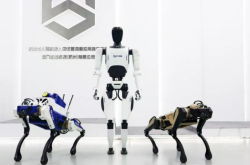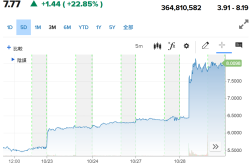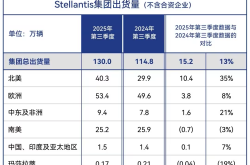Selling Like Hotcakes! Chinese Kids' Smartwatches: What Chip Opportunities Do They Present?
![]() 05/16 2025
05/16 2025
![]() 660
660
When one assumes that the watches adorning the wrists of "little kids" are merely niche toys, the reality is that children's smartwatches have quietly grown into a formidable force in the smart wearable market.
According to online monitoring data from RDI, children's smartwatches accounted for 31.5% of sales on traditional e-commerce platforms in 2024, almost on par with adult smartwatches (34.4%) and smart bracelets (34.4%).
In this arena, BBK (parent company of Xiaotiancai) dominates not just China but also the global market. In the second quarter of 2024, Xiaotiancai (imoo) captured nearly half of the global children's smartwatch market share, emerging as a "hidden giant" in the children's smart wearable industry and ranking among the top five global wrist device manufacturers in 2024.
How did children's smartwatches become so popular? How big is this market? And which chips are benefiting from its growth?
01
Selling Like Hotcakes! Children's Smartwatches
A closer look at the top-selling children's smartwatches reveals a market far more "high-end" than imagined. Products priced above 300 yuan abound, with many popular models surpassing 10,000 units sold, making it a substantial market.
On Taobao's Xiaotiancai flagship store alone, the four children's phone watches with higher sales currently boast historical transaction data of over 700,000, 200,000, 80,000, and 60,000 units. At an average selling price of 600 yuan per unit, the sales of these four products exceed 600 million yuan. It's a veritable "golden track" for children's products.
Not only are individual children's smartwatches selling well, but the overall market shipment volume and scale have also expanded rapidly in recent years.
According to IDC data, as early as 2018, the shipment volume of children's smartwatches in China reached 21.67 million units, roughly three times that of adult smartwatches (6.54 million units) in the same period, with a year-on-year growth of 16.6%.
What does 21.67 million units signify? Estimated at an average unit price of 400 yuan, the scale of the Chinese children's smartwatch market in 2018 exceeded 8.6 billion yuan.
This market continues to grow. Public data shows that from 2015 to 2020, the demand for children's smartwatches increased steadily, with a compound annual growth rate of over 30%. According to predictions by Shanghai East Money Securities, by 2026, the market size of children's smartwatches in China will exceed 20 billion yuan.
Data from the China Industry Research Institute indicates that there are approximately 170 million children aged 5 to 12 in China, with roughly one in every three children owning a smartwatch.
Children's watches, once seen as toys and "electronic waste," are evolving into an emerging smart terminal market with significant spending power and technology-driven effects.
Unlike other popular products like air fryers and high-speed hair dryers, which followed the path of "brand first, white label later," the development of children's smartwatches began with white labels and gradually transitioned towards branding. Children's smartwatches are also the first electronic consumer products designed, manufactured, and exported to the world by Chinese companies.
The development of this market has undergone three main stages:
Around 2007, children's watch products started to emerge. In their initial stage, they predominantly adopted the "public board and public mold" model of white-label mobile phones, based on 2G modules or mobile phone solutions. Priced at tens to hundreds of yuan, they featured simple functions and a poor user experience, more akin to communication toys. In 2013, Qihoo 360 launched the "Children's Guardian" bracelet with only a positioning function. By 2014, the industry was still in the exploratory stage.
From 2015 to 2018, it entered the initial growth stage. In June 2015, Xiaotiancai released the first "Y01" with calling functionality, marking the industry's inception. The market heated up rapidly that same year, with Huawei Honor, iFLYTEK Taoyun, Xiaomi Mitu, Tencent, and others entering the fray.
With advancements in production technologies such as screens, batteries, mobile networks, sensors, and storage modules, and the emergence of major brands like BBK, 360, Xiaomi, Huawei, and iFLYTEK, the quality of children's smartwatches improved, attracting more capital attention. New players emerged successively, and the market scale of children's smartwatches began to increase steadily.
Today, children's smartwatches have entered a stage of rapid development. Since 2019, the penetration rate of children's smartwatches has been increasing, gradually becoming a necessity for children. Significant breakthroughs have been made in positioning accuracy, video clarity, and battery life, enabling high-end features like swimming-level waterproofing and front and rear dual-camera video.
Market competition has shifted from "usable" to "user-friendly," with brand manufacturers fully developing in terms of performance, quality, and service. Children's smartwatches are constantly moving towards high-quality and branding.
Among them, Xiaotiancai stands out in the children's smartwatch market, dominating the Chinese market. According to RDI data, online sales of children's watches reached 8.637 million units in 2024, with sales of 3.84 billion yuan and an average price of 444 yuan. Xiaotiancai had a market share of nearly 30%, with sales surging 178.9% year-on-year, far exceeding brands like Haojixing, Xiaomi, and Huawei.
Xiaotiancai is not only a pioneer in the initial stage of children's smartwatches but also benefits from the market's rapid development, quietly amassing wealth. Shipments soared from 1.076 million to 3.604 million units from 2015 to 2016, with cumulative sales exceeding 20 million units by 2020. Its success not only hinges on "brainwashing" advertising and marketing, such as sponsoring "Dad, Where Are We Going?", but also on accurately catering to parents' rigid demand for their children's safety and positioning.
Furthermore, Xiaotiancai's "closed social circle" is a strategic move. To fit in with their peers, children cannot do without Xiaotiancai, leading to high switching costs and strong repurchase rates. In terms of product layout, Xiaotiancai is divided into the entry-level Q series, mid-range D series, and high-end Z series (priced from 400 to 2000 yuan), forming a "Z > D > Q" hierarchy on campus. The confidence in brand premium makes Xiaotiancai's pricing strategy particularly robust.
02
Who Is Making Money? What Chips Are Used?
The children's smartwatch industry can be divided into three major segments: upstream suppliers of smartwatch components, primarily module suppliers, screen suppliers, and strap suppliers; midstream major smartwatch manufacturers; and downstream consumers, primarily individual consumers and enterprise consumers represented by the top three domestic operators.
From the upstream raw materials perspective, watch accessory materials include watch screens, watch straps, and watch cases, while electronic components encompass sensors, chips, etc. According to the Head Leopard Research Institute, the hardware equipment of China's smart wearable devices, namely sensors, chips, batteries, communication modules, and displays, collectively account for about 20% of the total cost.
Media reports indicate that for a children's smartwatch priced at 600 yuan, 60% of the cost is attributed to components like modules, straps, screens, and circuit boards. The cost differences for various types of straps, screens, and modules are substantial; product components such as watch cases, back covers, and motors are highly homogeneous, with minimal cost differences.
Overall, the most profitable segment is primarily the midstream head brand manufacturers. Although the upstream bears most of the costs, it is shared by numerous suppliers of electronic components, screens, straps, etc., coupled with issues like technology and pricing transparency, and homogenization, resulting in limited profits; whereas "Xiaotiancai" and others achieve higher gross margins through branding, ecology, pricing, and marketing, with profits highly concentrated.
The functionalities of children's smartwatches primarily rely on electronic components. Typically, children's smartwatches integrate 5 to 8 functional modules, including clock, positioning, battery, sensor, camera, etc., with core chips covering the smartwatch main control chip (or MCU), RF transceiver chip, RF front-end module, Bluetooth/Wi-Fi SoC, power management chip, and storage chip.
The collaborative evolution of these key chips and modules has continuously enhanced key indicators such as positioning accuracy, video call clarity, battery life, and waterproof performance, laying a strong product foundation for children's smartwatches.
Analyzing teardown data from three popular children's smartwatches, including Xiaotiancai's children's phone watch Z10 (currently the highest-priced model), Xiaotiancai's phone watch Q2A, and Huawei's children's watch 5 Pro, provides a clear picture of the chip solutions for mainstream children's smartwatches.
In terms of the main control chip, Xiaotiancai Z10 is equipped with the Qualcomm Snapdragon W5 wearable flagship chip, Xiaotiancai Q2A with the Unisoc UWS6131E processor, and Huawei 5 Pro with Ambiq Micro's Apollo3 Blue Plus (AMA3B) MCU.
The main control chip is undeniably the core. According to the "Disassembly Summary of 25 Smartwatches from 16 Brands" released by the Intelligent Research Institute in 2023, smartwatch main control chips include 16 solutions from 10 major chip manufacturers such as Actions, Ambiq, Hynix, Dialog, Furuikun, Hisilicon, Qualcomm, Realtek, Samsung, and Unisoc, adopted by 23 products from 15 brands. Among them, the main control chip manufacturers for children's smartwatches are primarily Unisoc and Qualcomm.
Additionally, Xiaotiancai Z10 is also equipped with Synaptics SYN430132HKUBG Bluetooth/Wi-Fi single-chip SoC and SYN47768KUB1G Global Navigation Satellite System SoC. Huawei 5 Pro utilizes the Qualcomm WCN3620 wireless connectivity chip.
For RF transceiver chips, Xiaotiancai Q2A employs the Unisoc SR3595D, while Huawei 5 Pro uses the MediaTek AG3335MN GPS/GNSS receiver.
Regarding RF front-end module chips, Xiaotiancai Z10 uses Onsemi OM9385, and Xiaotiancai Q2A uses Richwave RR88916-81H.
In terms of power management chips, Xiaotiancai Z10 utilizes Qualcomm PMW5100 PMIC, Xiaotiancai Q2A employs Unisoc SC2721G PMIC, and Huawei 5 Pro uses Qualcomm PMW3101 PMIC.
For storage chips, Xiaotiancai Z10 uses BIWIN 64G eMCP memory.
As for other electronic components, Xiaotiancai Z10 uses STMicroelectronics LSM6DSOWTR six-axis sensor and Sunlord Electronics SDCL0603Q series stacked ceramic inductors, among others; Xiaotiancai Q2A is equipped with Onsemi OM8443-65 multi-mode multi-band (MMMB) power amplifier (PA), Wellsemi ESD56241D18 TVS protection tube, and an acceleration sensor, among others, utilizing Chipmicro CM1003-BAE single-cell rechargeable lithium battery protection IC, as well as speaker and microphone units; Huawei 5 Pro is equipped with a 2-megapixel + 5-megapixel dual-camera, speaker, microphone, vibration motor, barometer, and other sensors, along with Sunlord Electronics SDCL0603Q series stacked ceramic inductors, etc.
From the above chip solutions, it is evident that domestic chips are gradually replacing imported chip solutions in children's smartwatches, and the trend of localization from chips to products is increasingly apparent.
However, industry insiders have pointed out that there is currently a phenomenon of "high price but low configuration" in many children's smartwatches. For instance, the currently market-priced Xiaotiancai Q2A, priced at 400-500 yuan, is equipped with the Unisoc UWS6131E chip, belonging to the W317 processor series, which only supports 2G/3G/4G networks and has not been upgraded to 5G, indicating a modest configuration.
03
Conclusion
Although domestic chips are accelerating their penetration into children's smartwatches, the real value lies not in the hardware itself but in the moat constructed by brand manufacturers through ecological barriers and user circles, firmly grasping the right to premium pricing. As the market scale of children's smartwatches continues to expand, the demand for core chips such as main control chips, communication modules, and power management will also increase accordingly. Domestic solutions are gradually replacing imported solutions, presenting substantial growth opportunities for China's chip manufacturers.







